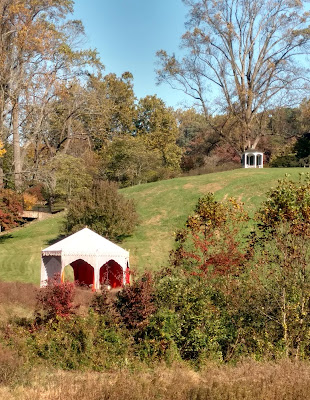When do your touch-ups cross a line and make your work a studio painting?
 |
| Autumn, by Carol L. Douglas |
Earlier this season, a reader asked me what I do with work that doesn’t sell at plein air events. Most artists use this work to sell elsewhere. Occasionally, however, we’ll bring home stuff that’s so site-specific it has no place in our current inventory.
Earlier this month, I painted a Moorish tent at Winterthur. It was one of about twenty garden follies they’d set up for the season. The pink, orange and turquoise confection flapped proudly in front of a blazing panorama of trees. However, nobody else seemed as amused as me; the painting garnered nary a second look.
 |
| To make the change, I had to remove the brush marks from the folly. First, I carefully applied a small amount of mineral spirits, taking care that they didn’t run. |
Yesterday, I excised the tent from the painting. I didn’t replace it with another focal point; I just let the landscape find its own structure.
It was necessary to get rid of the brushwork on the tent and the summerhouse so that they didn’t eventually appear in the surface as pentimenti. Because this painting is only a few weeks old, I was able to soften the paint with mineral spirits, and then carefully scrape down the top layer until it was flat.
| Gently, gently. You just want to take down the ridges. |
It wasn’t necessary to remove all the paint, just the ridges. If you do this, be careful to confine the mineral spirits to the area you want to correct. It will soften both good and bad passages indiscriminately. And don’t press while scraping; you’ll distort the canvas.
 |
| Bye-bye, Moorish tent! |
Then it was a matter of mixing some new green to fill in the area. If you aren’t careful at this point, you’ll end up repainting half your canvas trying to get the color right. You aren’t mixing a wall paint, so you’ll need to mix a few tightly-analogous colors. Then make sure you use a similar brush to the one you used originally.
This painting probably has about fifty added brushstrokes from the original. Is it still plein airfor the purposes of jurying? I used no additional reference, and the modification, although striking, was small. I think it counts, but I’m interested in what other people have to say.
 |
| Penobscot, by Carol L. Douglas |
The second painting I changed was one done in Santa Fe in April. At the time, I realized that a few brushstrokes would convert this to Penobscot Bay. It has been curing too long to open the surface and flatten it. It didn’t need that, in fact. It does not have one single bit of solid paint over the old painting; every change was made by glazing. Again, there was no reference used and very little paint. However, the subject has changed completely. Is it still plein air? I don’t think so because the finished work has no basis in reality.
| Sunset, by Carol L. Douglas |
The third painting I included because it has had absolutely nothing done to it. I painted it with Poppy Balser on a brilliant, cold evening at Rockport harbor last month and tossed it on the pile to be finished later. Pulling it out, I realized it needs nothing. It’s bright and fresh and perfect as is.

